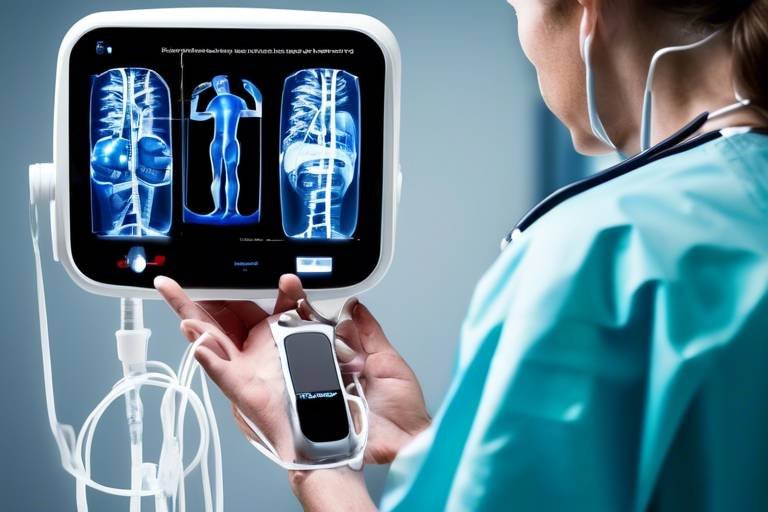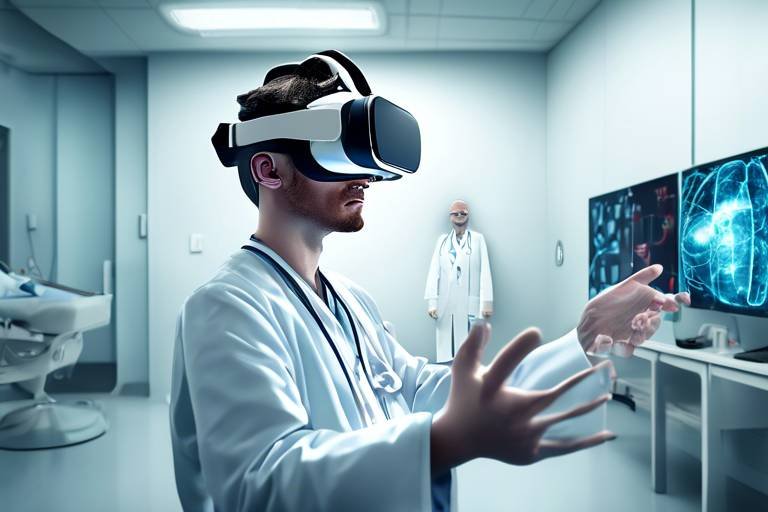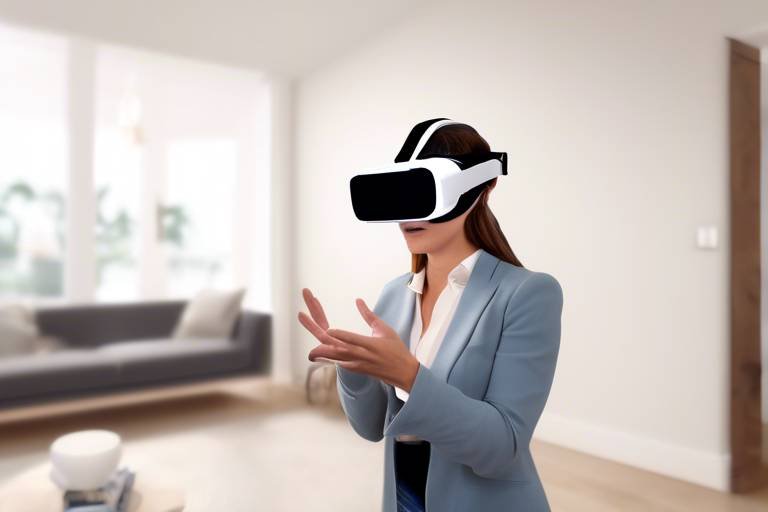Wearable Tech in Healthcare: A Potential Game Changer?
In recent years, the healthcare landscape has been dramatically reshaped by the emergence of wearable technology. These innovative devices, ranging from smartwatches to fitness trackers, are not just trendy accessories; they are revolutionizing the way we approach health and wellness. Imagine a world where your wristband can monitor your heart rate, track your sleep patterns, and even alert your doctor if something goes awry—all in real time. This isn't science fiction; it's the reality of wearable tech in healthcare today!
But what exactly makes these devices so transformative? For starters, they empower patients to take control of their health like never before. With the ability to continuously gather data, wearables provide a wealth of information that can lead to better decision-making and improved health outcomes. It's akin to having a personal health assistant right on your wrist, constantly providing insights and nudges towards healthier choices. However, with great power comes great responsibility, and the rise of wearable tech also brings challenges that we must navigate carefully.
As we delve deeper into this topic, we'll explore the various types of wearable devices available, the multitude of benefits they offer, and the hurdles they face in gaining widespread acceptance. From real-time health monitoring to chronic disease management, the potential applications are vast. Yet, we must also address critical issues such as data privacy and regulatory challenges. So, buckle up as we embark on this journey to uncover whether wearable technology is indeed a game changer in the healthcare sector!
Wearable technology encompasses a wide array of devices designed to monitor health metrics and enhance the user’s overall well-being. These gadgets can be broadly categorized into several types, each serving unique purposes within the healthcare landscape. For instance, fitness trackers are primarily focused on physical activity and sleep patterns, while smartwatches often integrate features like heart rate monitoring and ECG capabilities. Some wearables even cater specifically to chronic conditions, offering tailored functionalities that help patients manage their health more effectively.
Here's a brief overview of some common types of wearable devices:
| Type of Wearable | Functionality |
|---|---|
| Fitness Trackers | Monitor steps, calories burned, and sleep quality. |
| Smartwatches | Track heart rate, receive notifications, and monitor fitness levels. |
| Medical Wearables | Provide data on chronic conditions like diabetes and heart disease. |
| Smart Clothing | Integrate sensors that track various health metrics directly from the fabric. |
Each of these devices plays a pivotal role in how we monitor and manage our health. As technology continues to evolve, we can expect even more sophisticated wearables to emerge, further bridging the gap between patients and healthcare providers.
The benefits of wearable devices in healthcare are numerous and compelling. One of the most significant advantages is real-time health monitoring. With wearables, patients can keep tabs on vital health metrics continuously, enabling healthcare providers to make informed decisions based on up-to-date data. This immediacy can be lifesaving, particularly for individuals with chronic conditions who require consistent monitoring.
Furthermore, wearables facilitate proactive healthcare management. Instead of waiting for a scheduled appointment to discuss health concerns, patients can share their data with doctors instantly, allowing for timely interventions. This shift from reactive to proactive care is akin to having a safety net that catches potential health issues before they escalate.
Imagine receiving an alert on your smartphone when your heart rate spikes unexpectedly. That’s the power of real-time health monitoring through wearables. Continuous tracking allows for immediate data access, which can enhance patient care significantly. For example, if a patient with a heart condition experiences irregular heartbeats, their wearable can notify them and their healthcare provider instantly, enabling swift action.
Wearable tech is particularly crucial for managing chronic diseases. Devices designed for conditions like diabetes can monitor blood sugar levels and send alerts when readings are outside the normal range. This real-time feedback helps patients adjust their diets or insulin intake accordingly, leading to better disease management and improved quality of life.
Preventive healthcare is another area where wearables shine. By encouraging healthier lifestyles through activity tracking and sleep monitoring, these devices help users identify and mitigate potential health risks before they become serious issues. Think of wearables as your personal health coach, nudging you towards better habits and early detection of health anomalies.
However, as we embrace the benefits of wearable technology, we must also confront the challenges it brings, particularly regarding data privacy and security. Wearables collect sensitive health information, raising concerns about how this data is stored and shared. Patients must be assured that their information is protected against breaches and misuse. Addressing these concerns is crucial for fostering trust and encouraging broader adoption of wearable devices in healthcare.
Despite their potential, wearable technologies face several challenges in healthcare. One significant barrier is the complex regulatory landscape that governs medical devices. Companies must navigate a maze of compliance standards, which can slow down innovation and hinder the introduction of new products to the market.
Meeting regulatory requirements is essential for ensuring the safety and efficacy of wearable devices. However, the process can be daunting, particularly for startups and smaller companies. Understanding the nuances of regulations and obtaining necessary approvals can take time, which may delay the deployment of potentially life-saving technologies.
Finally, patient engagement is crucial for the success of wearable devices. If patients are not motivated to use these tools, their potential benefits will remain untapped. Factors such as user experience, ease of use, and perceived value play significant roles in determining whether patients will adopt these technologies. Manufacturers must focus on enhancing user experience to ensure that wearables become an integral part of patients' daily lives.
- What types of wearable devices are available in healthcare? There are various types of wearables, including fitness trackers, smartwatches, medical wearables, and smart clothing, each serving different health monitoring purposes.
- How do wearables improve patient outcomes? Wearables provide real-time health data, enabling proactive healthcare management and timely interventions, which can lead to better health outcomes.
- Are there privacy concerns with wearable technology? Yes, wearables collect sensitive health data, raising privacy and security concerns that need to be addressed to foster trust among users.
- What challenges do wearable technologies face in healthcare? Key challenges include regulatory hurdles, data privacy issues, and the need for patient engagement to ensure widespread adoption.

Understanding Wearable Technology
Wearable technology has revolutionized the way we approach health and wellness. These innovative devices are not just fancy gadgets; they are powerful tools that can monitor a variety of health metrics, providing real-time insights into our bodies. Imagine having a personal health assistant that fits right on your wrist or in your pocket! From smartwatches to fitness trackers, the landscape of wearable tech is vast and constantly evolving.
At its core, wearable technology encompasses any device that can be worn on the body, often incorporating sensors to track data such as heart rate, sleep patterns, physical activity, and even blood glucose levels. These devices are designed to be user-friendly and accessible, making health monitoring a part of our daily lives. Here are some common types of wearable devices:
- Fitness Trackers: These devices primarily focus on tracking physical activity, calories burned, and steps taken.
- Smartwatches: Beyond fitness tracking, smartwatches offer notifications, apps, and even health monitoring features like ECG (electrocardiogram) readings.
- Wearable ECG Monitors: These specialized devices provide detailed heart health metrics, allowing for early detection of potential issues.
- Smart Clothing: This innovative tech integrates sensors into clothing to monitor vital signs and physical performance.
Each of these devices plays a crucial role in the healthcare landscape, offering unique functionalities that cater to different needs. For instance, fitness trackers are fantastic for those looking to enhance their physical activity, while smartwatches can provide comprehensive health insights, making them suitable for a broader audience. With the integration of advanced sensors and connectivity features, wearables can now collect and transmit data seamlessly to healthcare providers, making them invaluable in patient care.
Moreover, the data collected from these devices can be analyzed to identify trends and patterns, which can help in making informed health decisions. Think of it as having a health diary that automatically updates itself! This constant stream of information not only empowers individuals to take charge of their health but also equips healthcare professionals with the necessary tools to deliver personalized care.
However, the journey of wearable technology in healthcare is not without its challenges. As we dive deeper into this exciting realm, we must also consider the implications of data privacy and security. After all, the information collected by these devices is sensitive and requires robust protection to ensure patient trust and compliance with healthcare regulations.
In summary, understanding wearable technology is crucial for both consumers and healthcare providers. These devices are not merely trends; they represent a significant shift towards a more proactive approach to health management. As we continue to explore their capabilities and potential, it becomes clear that wearable tech is not just a game changer—it's a potential lifeline for many individuals seeking to improve their health and well-being.

Benefits of Wearable Devices
Wearable devices have emerged as a revolutionary force in the healthcare sector, offering an array of benefits that extend far beyond mere convenience. These gadgets, which range from smartwatches to fitness trackers, are not just trendy accessories; they are powerful tools that can significantly enhance patient outcomes and reshape the healthcare landscape. Imagine having a personal health assistant that fits snugly on your wrist, continuously monitoring your vitals and alerting you to potential health issues before they escalate. This is the promise of wearable technology!
One of the most compelling advantages of wearable devices is their ability to provide real-time health monitoring. Unlike traditional methods that often rely on periodic check-ups, wearables allow for continuous tracking of various health metrics such as heart rate, blood pressure, and even sleep patterns. This constant stream of data can lead to more informed decisions by both patients and healthcare providers. For instance, a patient with a heart condition can receive immediate alerts about irregular heartbeats, enabling timely intervention that could save their life.
Additionally, wearables play a vital role in chronic disease management. For individuals managing conditions like diabetes, these devices can track glucose levels and notify users when their readings are outside the normal range. This not only empowers patients to take control of their health but also reduces the burden on healthcare systems by minimizing the need for emergency interventions. The ability to monitor chronic conditions in real-time means that patients can make informed lifestyle adjustments, leading to better management of their health.
Moreover, wearables significantly contribute to preventive healthcare. By encouraging users to adopt healthier lifestyles, these devices can help reduce the risk of developing serious health issues. For example, many wearables come equipped with features that track physical activity, reminding users to move if they've been sedentary for too long. This simple nudge can make a substantial difference in a person's overall health, promoting regular exercise and better dietary choices. In fact, studies have shown that individuals who use wearables are more likely to meet their fitness goals compared to those who don’t.
To illustrate the impact of wearable devices on health management, consider the following table:
| Benefit | Description |
|---|---|
| Real-Time Monitoring | Continuous tracking of vital signs enables timely interventions. |
| Chronic Disease Management | Helps patients manage conditions like diabetes and heart disease effectively. |
| Preventive Healthcare | Encourages healthier lifestyles and early detection of potential health issues. |
In conclusion, the benefits of wearable devices in healthcare are vast and varied. They not only facilitate real-time health monitoring and chronic disease management but also promote preventive healthcare practices. As technology continues to evolve, the potential for these devices to transform healthcare is enormous, making them a crucial component of modern health management strategies.
- What types of wearable devices are available? Wearable devices include fitness trackers, smartwatches, smart glasses, and health-monitoring devices.
- How do wearables improve patient outcomes? They provide real-time data, enabling timely interventions and better management of chronic diseases.
- Are there privacy concerns with wearable devices? Yes, as they collect sensitive health data, ensuring data privacy and security is crucial.

Real-Time Health Monitoring
In today's fast-paced world, the ability to monitor our health in real-time is nothing short of revolutionary. Imagine having a personal health assistant strapped to your wrist, constantly keeping an eye on your vital signs and alerting you to any anomalies. This is the promise of wearable technology in healthcare, where devices like smartwatches, fitness trackers, and specialized medical wearables are transforming how we approach our health. With real-time health monitoring, patients can access immediate data on their heart rate, blood pressure, oxygen levels, and even sleep patterns, all at their fingertips.
The implications of this technology are vast. For instance, consider a patient with a chronic condition such as hypertension. Instead of waiting for scheduled appointments to check their blood pressure, they can now receive continuous updates and alerts. If their readings spike unexpectedly, they can take immediate action—whether that means adjusting their medication or contacting their healthcare provider. This level of accessibility not only empowers patients but also fosters a proactive approach to health management.
Moreover, real-time monitoring facilitates timely interventions that can be life-saving. In emergency situations, every second counts. Wearable devices can alert both the user and emergency services if they detect a critical health event, such as a heart attack or severe arrhythmia. This capability can significantly improve outcomes and reduce the risk of complications.
To further illustrate the impact of real-time health monitoring, let's take a look at some key statistics:
| Statistic | Impact |
|---|---|
| 30% of patients report better health management | Improved adherence to treatment plans |
| 50% reduction in emergency room visits | Timely interventions prevent complications |
| 70% of users feel more in control of their health | Empowerment leads to healthier lifestyle choices |
However, while the benefits of real-time health monitoring are clear, it's essential to acknowledge that not all wearables are created equal. The accuracy of data collected can vary significantly between devices. Therefore, patients and healthcare providers must choose wearables that are clinically validated and reliable. In this way, real-time monitoring can truly become a game-changer in personalized healthcare, paving the way for a future where patients are more engaged and informed about their health than ever before.
In conclusion, real-time health monitoring through wearable technology is not just a trend; it represents a fundamental shift in how we perceive and manage our health. By providing immediate access to vital health data, wearables empower individuals to take charge of their well-being, leading to better health outcomes and a more proactive approach to healthcare.

Chronic Disease Management
Chronic diseases, such as diabetes, heart disease, and hypertension, are not just medical conditions; they are ongoing challenges that require constant attention and management. This is where wearable technology steps in as a game changer. Imagine having a personal health assistant strapped to your wrist, continuously monitoring your vital signs and providing real-time feedback. This capability is not just a luxury; it's becoming a necessity for effective chronic disease management.
Wearable devices, like smartwatches and fitness trackers, are equipped with sensors that can track a variety of health metrics, including heart rate, blood sugar levels, and even oxygen saturation. By collecting this data, wearables empower patients to take charge of their health. For instance, a diabetic patient can monitor their blood glucose levels throughout the day, allowing for timely adjustments in their diet or insulin intake. This proactive approach not only helps in maintaining optimal health but also significantly reduces the risk of complications.
Furthermore, these devices can be integrated with mobile applications that offer personalized insights and recommendations. For example, if a wearable device detects an abnormal heart rate, it can send an alert to the user, prompting them to seek medical advice. This immediate feedback loop is crucial in chronic disease management, as it allows for timely interventions that can prevent serious health issues.
To illustrate the impact of wearable technology on chronic disease management, consider the following table:
| Chronic Disease | Wearable Technology Application | Benefits |
|---|---|---|
| Diabetes | Continuous Glucose Monitors (CGMs) | Real-time blood sugar tracking, alerts for high/low levels |
| Heart Disease | Heart Rate Monitors | Early detection of irregularities, fitness tracking |
| Hypertension | Blood Pressure Monitors | Regular monitoring, medication adherence reminders |
Moreover, wearables can facilitate better communication between patients and healthcare providers. Data collected from these devices can be shared with doctors, allowing for more informed decisions during consultations. This level of connectivity helps in creating a comprehensive view of a patient's health, leading to tailored treatment plans that address individual needs.
While the benefits of wearable technology in chronic disease management are clear, it is essential to recognize that these devices are not a substitute for professional medical advice. Instead, they serve as valuable tools that enhance the overall healthcare experience. By combining technology with traditional healthcare practices, patients can achieve a more holistic approach to managing their chronic conditions, ultimately leading to a better quality of life.
- What types of wearables are best for managing chronic diseases? Devices like smartwatches with health tracking features, continuous glucose monitors, and blood pressure monitors are particularly effective.
- Can wearables replace traditional medical care? No, wearables should complement traditional healthcare, not replace it. They provide valuable data but should be used in conjunction with professional medical advice.
- How secure is the data collected by wearable devices? Most reputable devices use encryption and other security measures to protect user data, but it's always wise to review the privacy policies of the device manufacturers.

Preventive Healthcare
Wearable technology is revolutionizing the landscape of in ways we never thought possible. Imagine having a personal health assistant on your wrist, constantly monitoring your vital signs, activity levels, and even your sleep patterns. This is not just a futuristic dream; it's happening now! Wearable devices empower individuals to take charge of their health by providing real-time data that can lead to early detection of potential health issues.
One of the most significant advantages of wearables in preventive healthcare is their ability to encourage healthier lifestyles. For instance, many devices come equipped with features that track physical activity, remind users to move, and even monitor dietary habits. This constant feedback loop can motivate individuals to make better choices. Think of it like having a personal trainer who never leaves your side—always nudging you toward healthier decisions.
Moreover, wearables can also facilitate early detection of health problems. By continuously tracking metrics such as heart rate, blood pressure, and blood glucose levels, these devices can alert users to abnormalities that may require medical attention. For example, a sudden spike in heart rate during rest could indicate an underlying issue that needs to be addressed. This capability is akin to having a smoke detector in your home: it might not prevent a fire, but it can alert you before it gets out of control.
The data collected by wearable devices can also be invaluable for healthcare providers. When patients share their health metrics with their doctors, it allows for more personalized and proactive care. Physicians can analyze trends over time and make informed decisions about treatment plans. This collaborative approach between patients and healthcare providers can lead to improved health outcomes and reduced healthcare costs.
However, it’s essential to note that while wearables offer exciting possibilities for preventive healthcare, they are not a panacea. To fully realize their potential, users must be engaged and committed to utilizing these devices effectively. This means not only wearing them consistently but also understanding the data they provide and acting on it. After all, a wearable device is only as good as the actions it inspires.
In conclusion, wearable technology is a game changer for preventive healthcare. By fostering healthier lifestyles, enabling early detection of health issues, and enhancing the patient-provider relationship, these devices are paving the way for a more proactive approach to health management. As we continue to embrace this technology, the future of healthcare looks brighter than ever.
- What types of wearable devices are available for preventive healthcare? Wearable devices include fitness trackers, smartwatches, heart rate monitors, and continuous glucose monitors, each designed to track different health metrics.
- How can wearables help in early detection of health issues? By continuously monitoring vital signs and activity levels, wearables can alert users to abnormal readings that may indicate health problems.
- Are there any risks associated with using wearable technology? Yes, while wearables provide valuable data, there are concerns regarding data privacy and the accuracy of the information collected.
- How do I ensure I’m using my wearable device effectively? Engage with the data it provides, set health goals, and maintain a consistent routine to maximize its benefits.

Data Privacy and Security Concerns
In today’s digital age, where technology is seamlessly intertwined with our daily lives, the rise of wearable devices in healthcare brings a wave of excitement, but it also raises some serious . These devices, which track everything from heart rate to sleep patterns, collect sensitive personal information that could be misused if it falls into the wrong hands. Imagine wearing a device that not only monitors your physical activity but also holds your medical history—what happens if that data is compromised?
One of the biggest challenges with wearable tech is ensuring that the data collected is secure and that users feel confident in how their information is handled. Many wearables connect to mobile apps and cloud services, creating multiple points where data could potentially be exposed. This interconnectedness can lead to vulnerabilities, making it essential for manufacturers to implement robust security measures. For instance, encryption and secure data transfer protocols can help safeguard information from cyber threats.
Moreover, regulatory compliance plays a crucial role in addressing these privacy concerns. In the United States, the Health Insurance Portability and Accountability Act (HIPAA) sets strict guidelines on how personal health information should be protected. Companies that develop wearable tech must navigate these regulations to ensure they are not only compliant but also transparent with users about how their data is used. Failure to do so can result in hefty fines and a loss of trust from consumers.
Another aspect to consider is the user's role in maintaining their own data privacy. Many people may not fully understand the privacy policies associated with the wearables they use. This lack of awareness can lead to unintentional sharing of sensitive information. Therefore, it’s vital for manufacturers to provide clear, concise, and accessible information about data usage and privacy rights. Educating users on how to protect their data, such as adjusting privacy settings and understanding consent forms, is equally important.
In summary, while wearable technology holds tremendous potential to revolutionize healthcare, addressing is paramount. It requires a collaborative effort between manufacturers, healthcare providers, and users to create a secure ecosystem where personal health data is protected. Only then can we fully embrace the benefits of wearable devices without the looming fear of data breaches and privacy violations.
- What types of data do wearable devices collect? Wearable devices typically collect health metrics such as heart rate, sleep patterns, physical activity levels, and sometimes even blood sugar levels.
- How is my data protected when using wearable technology? Manufacturers implement various security measures, including encryption and secure data transfer protocols, to protect user data from unauthorized access.
- Are wearable devices HIPAA compliant? Many wearable device manufacturers strive to comply with HIPAA regulations, but it's essential for users to verify this with the company before sharing sensitive health information.
- Can I control what data is shared by my wearable device? Yes, most wearable devices allow users to adjust privacy settings and choose what information is shared and with whom.

Challenges in Implementation
Despite the promising advancements in wearable technology, the journey towards widespread adoption in healthcare is not without its hurdles. One of the primary challenges lies in the integration of these devices into existing healthcare systems. Healthcare providers often grapple with how to incorporate new technology into their workflows without disrupting patient care. Imagine trying to fit a square peg into a round hole; that’s how it feels when trying to adapt cutting-edge wearables into traditional settings. The complexity of existing systems can create resistance from healthcare professionals who are accustomed to conventional methods.
Another significant barrier is the regulatory landscape. Navigating the myriad of regulations set forth by health authorities can be daunting for tech companies. They must ensure that their devices meet stringent compliance standards while still innovating. This often leads to delays in bringing new products to market. For instance, the FDA has specific guidelines that wearable manufacturers must follow, which can sometimes stifle creativity and slow down the development process. Below is a table summarizing the key regulatory challenges:
| Regulatory Challenge | Description |
|---|---|
| Compliance with FDA Regulations | Wearable devices must meet specific safety and efficacy standards. |
| Data Privacy Laws | Compliance with HIPAA and other privacy regulations is essential. |
| Certification Processes | Obtaining necessary certifications can be time-consuming and costly. |
Then there’s the issue of patient engagement. For wearables to be effective, patients need to be actively involved in their health management. However, many individuals are hesitant to adopt new technologies, often due to a lack of understanding or fear of the unknown. It's akin to learning to ride a bike; initially daunting, but with practice, it becomes second nature. To overcome this, healthcare providers must prioritize education and support, helping patients to see the value of wearables in their daily lives. This might involve personalized demonstrations or workshops that highlight the benefits of real-time health tracking.
Moreover, data privacy and security concerns cannot be overlooked. As wearables collect sensitive health information, the risk of data breaches becomes a pressing issue. Patients want to know that their health data is secure, and any lapses could lead to a significant loss of trust in these technologies. Healthcare providers and tech companies must collaborate to implement robust security measures, ensuring that patient information is encrypted and protected from unauthorized access. This collaboration could include regular audits and updates to security protocols, creating a safe environment for both patients and providers.
In summary, while wearable technology holds incredible potential for transforming healthcare, several challenges must be addressed for successful implementation. From regulatory hurdles and patient engagement to data security, overcoming these obstacles will require a concerted effort from all stakeholders involved. As we move forward, it’s crucial to foster an environment of innovation and collaboration, paving the way for a future where wearables are seamlessly integrated into healthcare practices.
- What are wearable devices? Wearable devices are technology gadgets worn on the body that monitor health metrics, such as heart rate, activity levels, and more.
- How do wearables improve patient care? They provide real-time health data, enabling timely interventions and better chronic disease management.
- What are the main challenges of implementing wearable tech in healthcare? Key challenges include regulatory compliance, patient engagement, and data privacy concerns.
- How can patients be encouraged to use wearable devices? Education and personalized support can help patients understand the benefits of wearables, encouraging adoption.

Regulatory Hurdles
This article explores the transformative role of wearable technology in healthcare, examining its benefits, challenges, and future potential in enhancing patient care and outcomes.
Wearable technology encompasses devices that monitor health metrics. This section delves into the different types of wearables and their functionalities in the healthcare landscape.
Wearable devices offer numerous advantages, including real-time health monitoring and data collection. This section highlights how these benefits can lead to improved patient outcomes and proactive healthcare management.
Real-time health monitoring through wearables allows for immediate data access. This subheading discusses how continuous tracking can enhance patient care and facilitate timely interventions.
Wearable tech plays a crucial role in chronic disease management. This section examines how devices help patients manage conditions like diabetes and heart disease more effectively.
Preventive healthcare is significantly enhanced by wearables. This part explores how these devices encourage healthier lifestyles and early detection of potential health issues.
As wearables collect sensitive health data, privacy and security concerns arise. This section addresses the challenges and solutions related to safeguarding patient information.
Despite their potential, wearable technologies face several challenges in healthcare. This section discusses barriers to widespread adoption and integration into existing health systems.
Navigating the regulatory landscape can be a daunting task for companies venturing into the world of wearable technology in healthcare. The complexity arises from the need to comply with various standards set by health authorities, which can vary significantly across regions. For instance, in the United States, the Food and Drug Administration (FDA) plays a pivotal role in assessing the safety and efficacy of medical devices, including wearables. This means that companies must invest time and resources into ensuring their products meet stringent guidelines before they can hit the market.
Moreover, the rapid pace of technological advancement often outstrips the ability of regulatory bodies to develop appropriate frameworks. This can lead to a situation where innovative devices may be delayed in receiving approval, ultimately hindering their availability to patients who could benefit from them. Companies need to be proactive in understanding the regulatory requirements, which often include:
- Clinical Trials: Demonstrating the effectiveness of the device through rigorous testing.
- Quality Management Systems: Implementing processes to ensure consistent product quality.
- Post-Market Surveillance: Monitoring the device's performance once it is in use.
Additionally, the global nature of healthcare means that companies must also consider international regulations, which can add another layer of complexity. For example, the European Union has its own set of regulations under the Medical Device Regulation (MDR) that companies must adhere to, which may differ significantly from FDA requirements. This can create confusion and delay for companies trying to launch their products in multiple markets.
In conclusion, while the potential for wearable technology in healthcare is immense, the regulatory hurdles present a significant challenge that companies must navigate carefully. By staying informed and adaptable, they can better position themselves to overcome these obstacles and bring innovative solutions to the patients who need them most.
- What are wearable devices in healthcare? Wearable devices in healthcare are technology-enabled gadgets that monitor and collect health-related data, such as heart rate, activity levels, and sleep patterns.
- How do regulatory hurdles affect wearable tech? Regulatory hurdles can delay the approval process for wearable devices, making it challenging for companies to bring their innovations to market.
- Are there privacy concerns with wearable technology? Yes, since wearables collect sensitive health data, there are significant privacy and security concerns that need to be addressed to protect patient information.

Patient Engagement and Adoption
When it comes to the success of wearable technology in healthcare, patient engagement is not just important; it's absolutely critical. Imagine trying to run a marathon without training; that's how challenging it can be for healthcare providers if patients don't actively engage with their wearable devices. These devices, designed to monitor health metrics, can only be effective if patients are willing to wear them regularly and understand their benefits. So, what really drives patient engagement? Let's dive deeper.
First off, awareness and education play a massive role in encouraging patients to adopt wearable technology. Many individuals may not fully grasp how these devices work or the potential benefits they offer. For instance, a smartwatch that tracks heart rate or a fitness band that monitors steps can seem like just another gadget unless patients understand how these metrics can lead to better health outcomes. Therefore, healthcare providers need to take the initiative to educate patients about the advantages of wearables. This could be done through workshops, informational brochures, or even one-on-one consultations. The more informed patients are, the more likely they are to embrace these technologies.
Moreover, the user experience of wearable devices significantly influences patient adoption. If a device is complicated to use or uncomfortable to wear, patients are likely to abandon it quickly. Manufacturers and developers should focus on creating user-friendly interfaces and ergonomic designs. For example, a sleek, lightweight fitness tracker that syncs effortlessly with a smartphone app will likely see higher adoption rates compared to a clunky device with a confusing interface. In this context, design matters—a lot!
Another key factor in patient engagement is the feedback loop. Wearable devices can provide real-time data that patients can view and understand, but what happens next? If patients receive actionable insights based on their data—like reminders to take medication or alerts about irregular heart rates—they're more likely to see the value in wearing these devices. This feedback can empower patients, making them feel more in control of their health. A study showed that patients who received personalized health tips based on their wearable data were significantly more engaged than those who did not.
In addition, social support plays a pivotal role in encouraging patients to adopt wearable technology. When individuals feel supported—whether by family, friends, or even online communities—they are more likely to stick with their health goals. Imagine a group of friends who all wear fitness trackers and share their daily step counts; they motivate each other to achieve their goals. Healthcare providers can foster this sense of community by creating group challenges or support networks that encourage patients to share their experiences and progress.
Lastly, the issue of affordability cannot be overlooked. While many wearable devices are becoming more affordable, there are still significant barriers for some patients. Insurance coverage for these devices varies widely, and not everyone can justify the expense. To tackle this, healthcare systems could explore partnerships with manufacturers to provide subsidized devices or offer them as part of a comprehensive care package. Making wearables accessible to a broader audience is essential for widespread adoption.
In summary, patient engagement and adoption of wearable technology hinge on several factors, including education, user experience, feedback mechanisms, social support, and affordability. As we move forward in this digital age, it's crucial for healthcare providers to address these aspects to ensure that patients not only adopt wearable devices but also engage with them meaningfully. After all, the ultimate goal is to empower patients to take charge of their health, leading to better outcomes for everyone involved.
- What types of wearable devices are commonly used in healthcare? Wearable devices can include fitness trackers, smartwatches, heart rate monitors, and even smart clothing that tracks various health metrics.
- How can wearable technology improve patient outcomes? By providing real-time health data and feedback, wearables can help patients manage chronic conditions, maintain healthier lifestyles, and facilitate timely medical interventions.
- Are there privacy concerns with wearable technology? Yes, as wearables collect sensitive health information, it's crucial to ensure that data privacy and security measures are in place to protect patients' personal information.
- How can healthcare providers encourage patient engagement with wearables? Providers can educate patients about the benefits of wearables, ensure user-friendly designs, and create supportive communities to boost engagement.
Frequently Asked Questions
- What is wearable technology in healthcare?
Wearable technology in healthcare refers to devices that can be worn on the body to monitor health metrics such as heart rate, activity levels, and even sleep patterns. These devices provide valuable real-time data, helping both patients and healthcare providers make informed decisions about health management.
- How do wearable devices improve patient outcomes?
Wearable devices enhance patient outcomes by enabling real-time health monitoring. This immediate access to health data allows for timely interventions, better chronic disease management, and encourages preventive healthcare practices, ultimately leading to healthier lifestyles and improved overall well-being.
- Are there privacy concerns with using wearable technology?
Yes, there are significant privacy and security concerns associated with wearable technology. These devices collect sensitive health data, making it crucial to implement robust security measures to protect patient information from unauthorized access and breaches.
- What challenges do wearable technologies face in healthcare?
Wearable technologies encounter several challenges, including regulatory hurdles, patient engagement issues, and integration difficulties with existing health systems. These barriers can impede widespread adoption and effective utilization of wearable devices in healthcare settings.
- How can patients be encouraged to adopt wearable devices?
Encouraging patient adoption of wearable devices can be achieved through education about their benefits, improving user experience, and ensuring that devices are user-friendly. Demonstrating how wearables can empower patients to take control of their health can also enhance engagement.
- What types of conditions can wearable devices help manage?
Wearable devices are particularly beneficial for managing chronic conditions such as diabetes, heart disease, and hypertension. They provide continuous monitoring, allowing patients and healthcare providers to track health metrics and make necessary adjustments in real-time.
- Can wearables contribute to preventive healthcare?
Absolutely! Wearable devices play a significant role in preventive healthcare by encouraging users to adopt healthier lifestyles, track their fitness levels, and detect potential health issues early. This proactive approach can lead to better health outcomes and reduced healthcare costs.



















